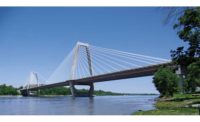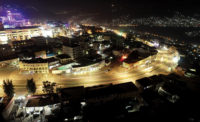Translating from Spanish into "coastal beltway," the Cinta Costera is Panama City's new urban hot spot. Part of a new master roadway plan designed to be built for the community and by the community, the job's third phase spans 5.2 kilometers and wraps around formerly depressed neighborhoods, where rival street gangs put down their weapons and replaced them with hardhats.
"The gang members generally came onboard as general labor, and as they gained more work experience, they moved on to bricklayers, masons, carpenters, welders and even foremen," says Francisco Martins, sustainability manager for Odebrecht in Panama.
Districts included in the redevelopment, including El Chorillo, were "kind of forbidden during night hours for any Panamanian to go there," adds Martins. "Now, people go there, and they have fun." The new roadway integrates historic neighborhoods, government districts and coastline with roads and bridges that simultaneously accommodate multiple transportation methods—cars, bicycles and walking.
"The Cinta Costera project is very important because it solves a transportation problem, but it also brought a social solution," Martins says.
Employment Opportunity
With a construction cost of $782 million, the project's requirement to use local labor that had no previous experience in civil works was a major challenge. Due to the violent social environment, the majority of local workers had never held a job. Employment opportunities, teamwork and ongoing training programs helped the rival gangs set aside their differences.
Despite these high risks, the project incorporated behavioral safety techniques to achieve an accident rate of 0.007 incidents per person, which the contractor Odebrecht says is very low, considering the size and complexity of the work. The project's average total recordable injury frequency rate was equally impressive, at just 0.93 for an average workforce of 2,500 people working 16.4 million total hours; and zero fatalities occurred, team members note.
Completed on an accelerated schedule, the project refreshes the fatigue of many public roads and disconnected neighborhoods in Panama City by creating a modern street platform that includes integrated vehicular, pedestrian, bicycling and park spaces—as well as a stadium—along a corridor of marine backfills. The three-year project, part of Panama's New Roadway System Master Plan, has quickly stimulated the development of the surrounding neighborhoods.
"It was done in record time," says Mariano Valle, senior vice president of engineering consultant T.Y. Lin in Coral Gables, Fla. "The crews worked 24/7."
Project Team
Owner: Ministerio de Obras Publicas
Contractor: Construtora Norberto Odebrecht
Lead Design Firm, Structural, MEP: T.Y. Lin International
Urban Design: Estudio Herreros SLP
Additional Design: Louis Berger Group






